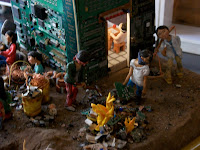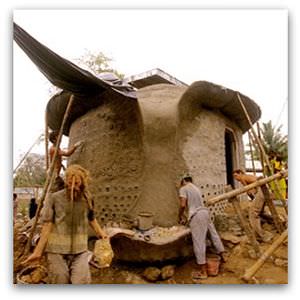
Monday, December 14, 2009
NPR: interview about contaminated water and its cause Dairy Farming

Thursday, December 3, 2009
House of Cards, Influence for my last project

Coral Bleaching
When corals lose their color, it is known as "coral bleaching". Coral bleaching became an issue when it was first observed on coral reefs in the South Pacific in the 1990's. Coral bleaching also occurs in saltwater reef aquariums. So what exactly is coral bleaching?
The skeletal structure of hard corals are normally white, but due to zooxanthellae algae, which are tiny plants called dinoflagellates (single-celled microscopic organisms which belong to the Protista kingdom) that reside within the soft tissues of corals, they have color. These microalgae are photosynthetic, and their relationship with some corals, as well as other marine life such as Tridanid clams, nudibranchs, some sponges and even jellyfishes, is an example of endosymbiosis (symbiosis - the intimate living together of two dissimilar organisms in a mutually beneficial relationship; endo - within).
Although long term bleaching can cause the partial or total death of coral colonies, if the situation is not too severe and stressful conditions are changed, it is possible for affected colonies to recover their symbiotic microalgae and start growing again.
Since stress seems to be the key to this problem occurring, let's evaluate what events are reported to be the cause of bleaching on coral reefs around the world.
The effects of el Nino and La Nina events.
What impact can these events have on marine ecosystems?
A change in ocean currents, which relates to changes in phytoplankton and zooplankton populations, as well the amount of other nutrients present in the water.
Increase/decrease in water temperatures.
Increase/decrease in water salinity.
Increase/decrease in air temperatures.
Build up of carbon dioxide and methane gases.
Exposure to increased ultraviolet radiation.
Exposure to high light levels.
Increased or high water turbulence.
Decrease in light levels.
Sedimentation, which relates to a decrease in light levels, as well as suffocation of sessile marine life.
Tuesday, December 1, 2009
Show at 21C Museum




Images from the show at the 21C Museum.
Leticia Bajuyo
Tuesday, November 24, 2009
Crafty Art With A Purpose
Food Not Bomb

http://www.foodnotbombs.net/story.html
REcycled Art of Jen Grant


Artist Statement:
"SWING was created from discarded items of clothing collected from the back alleys and bin areas of tenements in Glasgow. The clothes were then laundered and dried, cut into strips, and woven together to fashion ropes, to which parts of chairs (also found on the streets) were attached to form swings. These were hung from the guardrails on the Botanic Gardens Bridge that crosses the river Kelvin and forms part of the busy Kelvin Walkway.
The clothes that were collected and used for this project were imbued with a personality and invoked very powerfully notions of the abject, each piece telling a story of sorts, albeit ambiguously, about its previous owners and their lives and experiences. The cutting and braiding together of these items seemed almost like weaving together small fragments of narratives from the lives of a myriad of unknown people, creating an object that at once juxtaposes these fragments while creating a new narrative of its own."
Ephemeral Art : Sand Mandala


http://www.artbabble.org/video/creation-sand-mandala
Lama Karma Tenzin created a sand mandala in the theater gallery of the Rubin Museum of Art in NYC. The mandala took over two weeks to create out of millions of grains of crushed marble and under two minutes to destroy. Lama Karma visited the Rubin Museum of Art in conjunction with The Dragon's Gift - The Sacred Arts of Bhutan exhibition.
This video struck me because it reminded me of topics discussed early in the year. I think Lexie did a sand mandala. This is a great video because the mandala is well executed, but also the removal is just as artfully done and respectful as the addition process.
Tuesday, November 17, 2009
Tree Hugger Blog

New Cardbaord ARt
Robert Rauschenberg: Cardbird...Recycled Art


Thursday, November 12, 2009
Lecture November 12th with Avery Kolers
Garbage Warrior
Earthship n. 1. passive solar home made of natural and recycled materials 2. thermal mass construction for temperature stabilization. 3. renewable energy & integrated water systems make the Earthship an off-grid home with little to no utility bills.
Biotecture n. 1. the profession of designing buildings and environments with consideration for their sustainability. 2. A combination of biology and architecture.
For 30 years New Mexico-based Reynolds and his green disciples have devoted their time to advancing the art of "Earthship Biotecture" by building self-sufficient, off-the-grid communities where design and function converge in eco-harmony. However, these experimental structures that defy state standards create conflict between Reynolds and the authorities, who are backed by big business. Frustrated by antiquated legislation, Reynolds lobbies for the right to create a sustainable living test site. While politicians hum and ha, Mother Nature strikes, leaving communities devastated by tsunamis and hurricanes. Reynolds and his crew seize the opportunity to lend their pioneering skills to those who need it most. Shot over three years and in four countries, Garbage Warrior is a timely portrait of a determined visionary, a hero of the 21st century.
Click on the link to watch trailer for movie. Learn more about the film.
http://www.garbagewarrior.com/index.php

Water Crisis

Unfortunately, humans have proved to be inefficient water users. (The average hamburger takes 2,400 liters, or 630 gallons, of water to produce, and many water-intensive crops, such as cotton, are grown in arid regions.)
According to the United Nations, water use has grown at more than twice the rate of population increase in the last century. By 2025, an estimated 1.8 billion people will live in areas plagued by water scarcity, with two-thirds of the world's population living in water-stressed regions as a result of use, growth, and climate change.
(information found on site)
EPA Ready to Dole Out 'Environmental Justice" Grant for Budding Activists.

http://www.cnsnews.com/news/article/56934
CNSNews.com) - The U.S. Environmental Protection Agency is accepting grant applications for projects aimed at addressing environmental and public health issues in “communities with environmental justice concerns.”
The EPA said it expects to award approximately 40 grants of up to $25,000 each in Fiscal 2010. It will accept applications until January 8, 2010.
Local governments and non-profit organizations are eligible to apply. (Ineligible institutions include hospitals, colleges and universities, state governments, quasi-governmental entities, nonprofits that engage in lobbying, and national, multi-state, or statewide organizations with chapters.)
Mountain Justice Website


Tuesday, November 3, 2009
Tire Art buddha
Trip to Bernheim Forest





I took a trip to Bernheim Forest last weekend.
PIctures of the Alter KMAC Native Americans of the Ohio Valley Region: story of the Beaver Clan Family
Great Blog spot


http://atangledbank.blogspot.com
Tuesday, October 27, 2009
Interested in growing an organic garden?

http://www.thegreenguide.com/home-garden/garden/natural-seeds-garden
Whales misfortune becomes a researcher's laboratory

October 22, 2009
The apparent victim of a ship collision, a dead 70-foot (20-meter) blue whale (pictured) washed ashore in a forbidding northern California cove this week.
Though unable to move the blue whale, scientists and students are leaping at the research opportunity, scrambling down rock faces to take tissue samples and eventually one of the 11-foot-long (3.5-meter-long) flippers.
Though relatively infrequent off California until recent years, ship collisions are "the number one human threat to blue whales," according to marine biologist Joe Cordaro of the U.S. National Marine Fisheries Service.
This week's collision, he said, marks the second time this year that a ship off California has fatally wounded a blue whale.
The world's largest animals, blue whales can grow to about a hundred feet (30 meters) long—about the length of a space shuttle. Listed as endangered by the International Union for Conservation of Nature, the whales are said to face a very high risk of extinction in the wild, largely due to heavy hunting prior to a 1966 ban.
It is thought that the because of the fresh propeller wound that a ship was the culprit of this whales demise. Blue Whale Tragedy Turned Scientific Windfall
"I'm as sorry as anybody that that animal perished," said Humboldt State University mammologist Thor Holmes (pictured above atop the whale). But to find "a fresh, female blue whale in a place that's accessible—that is amazing."
On Tuesday, Holmes and two students drove several hours to study the blue whale.
On the shore, the researchers took blubber samples, which Holmes expects will shed light on the whale's pre-collision health.
"Just the fact that the whale has a good, thick blubber layer," he said, "shows it was a really, really healthy animal."
Blue Whale to Be Left in Place
The blue whale will be left on the Fort Bragg beach, the National Marine Fisheries Service's Cordaro said. Given the cove's inaccessibility to vehicles, he added, "That whale ain't going anywhere."
But researchers are planning more tests, including an amputation of one of the blue whale's flippers this week—a potential windfall for an ongoing Humboldt For Holmes, the specimen holds great scientific promise, but also serves as a painful reminder of humanity's role in the blue whale's rarity.
"The presence of that animal on the beach," he said, "is another sign that we're malefactors on this planet."
—Ted Chamberlain
Whale photograph by Larry Wager, AP
Tuesday, October 20, 2009
EPA's Definition of Sustainability
What is sustainability?
The U.S. National Environmental Policy Act of 1969 declared as its goal a national policy to "create and maintain conditions under which [humans] and nature can exist in productive harmony, and fulfill the social, economic and other requirements of present and future generations of Americans."
The most widely quoted definition internationally is the "Brundtland definition" of the 1987 Report of the World Commission on Environment and Development – that sustainability means "meeting the needs of the present without compromising the ability of future generations to meet their own needs." (EPA's Region 10 Sustainability Web site provides more information on definitions and history of "Sustainability.")
Region 10 website: http://yosemite.epa.gov/r10/oi.nsf/sustainability/sustainability/
National Biofuels Action Plan

http://www1.eere.energy.gov/biomass/pdfs/nbap.pdf
Made by the efforts of the Biomass Research and Development Board
its one year old but this document is fairly easy to read plus it reminded me of Lori Beck lecture with the class.
It starts out by outlining the current problem with fossil fuel production shows a couple of graphs and then the petroleum supply and demand. It follows with the topic of sustainability. Graphs of the target of biofuel supply change. It ends with hope for the future of environment, health and safety and a timeline for biofuels commercialization all and all it was a fairly easy article to read and there is a link to contact information for the Office of the Assistant Secretary Energy Effciency and Renewable Energy, the USDA and The Biomass research and development Initiative.
International conference on Sustainable cities
Thursday, October 15, 2009
Sustainability a definition
Artist I am digging

This is just one example of artwork by Mara Adamtz Scrupe, this is a solar powered sculpture made from resin tree, it also has a solar powered irrigation system built into it. Why you would need to water it I have no idea, but this and the others projects on here website where beautiful, formal and conceptually.















